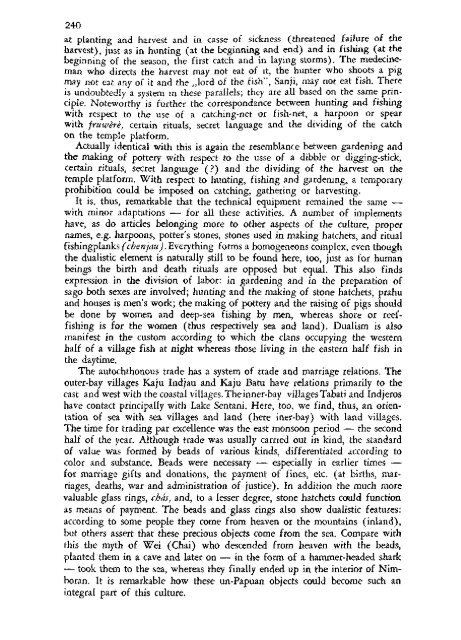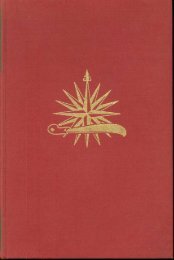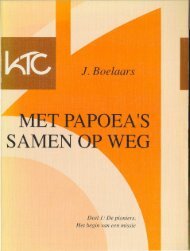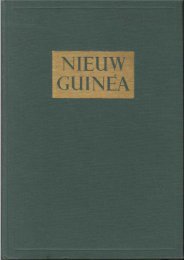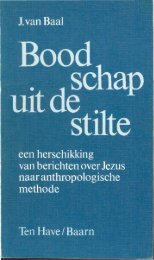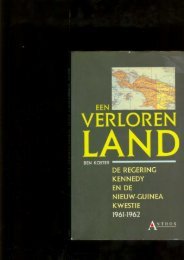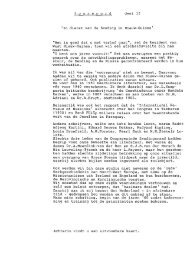Untitled - Stichting Papua Erfgoed
Untitled - Stichting Papua Erfgoed
Untitled - Stichting Papua Erfgoed
Create successful ePaper yourself
Turn your PDF publications into a flip-book with our unique Google optimized e-Paper software.
240<br />
at planting and harvest and in casse of sickness (threatened failure of the<br />
harvest), just as in hunting (at the beginning and end) and in fishing (at the<br />
beginning of the season, the first catch and in laying storms). The medecineman<br />
who directs the harvest may not eat of it, the hunter who shoots a pig<br />
may not eat any of it and the „lord of the fish", Sanji, may not eat fish. There<br />
is undoubtedly a system in these parallels; they are all based on the same principle.<br />
Noteworthy is further the correspondance between hunting and fishing<br />
with respect to the use of a catching-net or fish-net, a harpoon or spear<br />
with fruwèrè, certain rituals, secret language and the dividing of the catch<br />
on the temple platform.<br />
Actually identical with this is again the resemblance between gardening and<br />
the making of pottery with respect to the usse of a dibble or digging-stick,<br />
certain rituals, secret language (?) and the dividing of the harvest on the<br />
temple platform. With respect to hunting, fishing and gardening, a temporary<br />
prohibition could be imposed on catching, gathering or harvesting.<br />
It is, thus, remarkable that the technical equipment remained the same •—<br />
with minor adaptations — for all these activities. A number of implements<br />
have, as do articles belonging more to other aspects of the culture, proper<br />
names, e.g. harpoons, potter's stones, stones used in making hatchets, and ritual<br />
fishingplanks (chenjau). Everything forms a homogeneons complex, even though<br />
the dualistic element is naturally still to be found here, too, just as for human<br />
beings the birth and death rituals are opposed but equal. This also finds<br />
expression in the division of labor: in gardening and in the preparation of<br />
sago both sexes are involved; hunting and the making of stone hatchets, prahu<br />
and houses is men's work; the making of pottery and the raising of pigs should<br />
be done by women and deep-sea fishing by men, whereas shore or reeffishing<br />
is for the women (thus respectively sea and land). Dualism is also<br />
manifest in the custom according to which the clans occupying the western<br />
half of a village fish at night whereas those living in the eastern half fish in<br />
the daytime.<br />
The autochthonous trade has a system of trade and marriage relations. The<br />
outer-bay villages Kaju Indjau and Kaju Batu have relations primarily to the<br />
east and west with the coastal villages. The inner-bay villages Tabati and Indjeros<br />
have contact principally with Lake Sentani. Here, too, we find, thus, an orientation<br />
of sea with sea villages and land (here iner-bay) with land villages.<br />
The time for trading par excellence was the east monsoon period — the second<br />
half of the year. Although trade was usually carried out in kind, the standard<br />
of value was formed by beads of various kinds, differentiated according to<br />
color and substance. Beads were necessary — especially in earlier times —<br />
for marriage gifts and donations, the payment of fines, etc. (at births, marriages,<br />
deaths, war and administration of justice). In addition the much more<br />
valuable glass rings, chás, and, to a lesser degree, stone hatchets could function<br />
as means of payment. The beads and glass rings also show dualistic features:<br />
according to some people they come from heaven or the mountains (inland),<br />
but others assert that these precious objects come from the sea. Compare with<br />
this the myth of Wei (Chai) who descended from heaven with the beads,<br />
planted them in a cave and later on — in the form of a hammer-headed shark<br />
— took them to the sea, whereas they finally ended up in the interior of Nimboran.<br />
It is remarkable how these un-<strong>Papua</strong>n objects could become such an<br />
integral part of this culture.


